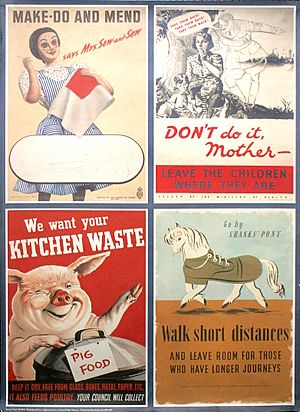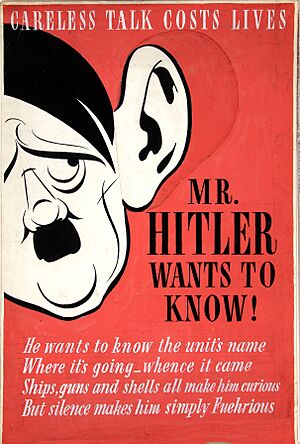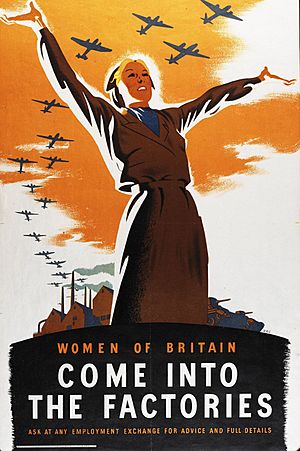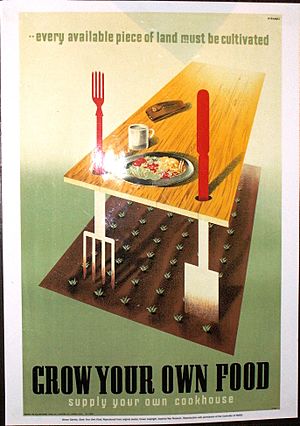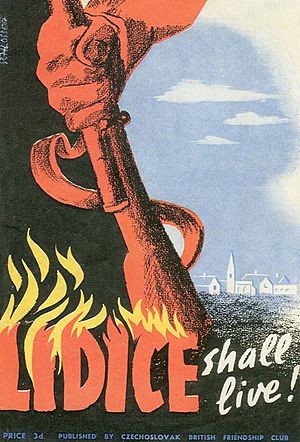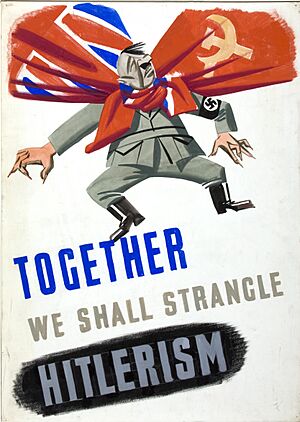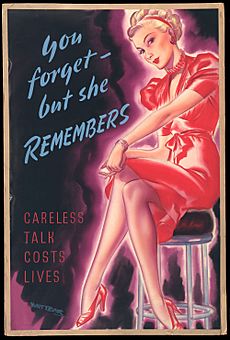British propaganda during World War II facts for kids
Britain created the World War II Ministry of Information (MOI) to help people support the war effort. They used many ways to share messages with people in Britain and other countries. Old ways like newspapers and posters were used, but new things like movies, newsreels (short news films), and radio became very important.
The MOI spread messages about many things. They wanted people to dislike the enemy, support Britain's friends, and help with war projects. This included saving metal and growing vegetables.
The Ministry of Information (MOI) was set up on September 4, 1939. This was the day after Britain declared war. The MOI was in charge of all public messages and propaganda during the war. Its main job was to "show the country's side to people at home and abroad."
Movies
Movies were a big part of how the MOI shared its messages. British war films often told exciting stories. At the same time, they included ideas to support the Allies (Britain and its friends).
In 1940, Kenneth Clark, who led the MOI's Films Division, said people needed to see how cruel Germany was. He wanted films to show "the evil things which confront us" to make people want to keep fighting.
Later in the war, films started showing the tough life in countries taken over by Germany.
- The Day Will Dawn (1942) was about the Norwegian resistance (people fighting back).
- Uncensored (1942) told the story of the Belgian resistance.
- Tomorrow We Live (1943) showed brave French people in the French Resistance.
- One of Our Aircraft Is Missing (1942) showed Dutch people risking their lives to help British airmen get back to England.
Movies from other countries were also shown. Winston Churchill, Britain's Prime Minister, even ordered that Frank Capra's Why We Fight series from America be shown to the public.
Newsreels
Newsreels were short films shown in cinemas before the main movie. They showed news events and were very powerful. For example, images of St. Paul's Cathedral standing tall over bombed-out London helped show British strength to American audiences.
Posters
Posters were used everywhere to spread messages. Some gave simple instructions, while others were meant to make people feel more hopeful. For example, London Transport had a series of posters with a character called Billy Brown of London Town.
Motivational Posters
In April 1939, the British government made three special motivational posters. They were:
- "Freedom is in peril, defend it with all your might."
- "YOUR COURAGE, YOUR CHEERFULNESS AND YOUR RESOLUTION WILL BRING US VICTORY"
- "Keep Calm and Carry On"
These posters were designed to make people feel strong and determined. However, they were not often displayed, and most of them were destroyed in 1940.
Leaflets
Leaflets were often dropped from airplanes over enemy areas. This was a way to spread messages to people living under enemy control. For example, in 1941, on the anniversary of Hitler's false claim of victory against the Soviet Union, copies of a German newspaper reporting the story were dropped over Germany.
Books
The MOI also published books for other government departments. For instance, they made 'The Army at War' series for the War Office. After D-Day, many books were sent to France to be given to French booksellers. These included books from both American and British authors.
Radio
Radio was a very important way to share messages. Broadcasts were made in 23 different languages. It was easier to reach people in occupied countries by radio than in Germany itself.
Edward R. Murrow, an American journalist, made famous radio reports about the Blitz (German bombing raids on Britain). His calm and factual reports helped show Americans the courage of the British people. He even had access to Churchill.
Transmitters in England sometimes pretended to be broadcasting from Germany. These broadcasts usually gave mostly true reports, but they also included some false information to confuse the enemy.
Main Messages
Fighting Back
During the early part of the war, a book called Why Britain is at War sold 100,000 copies.
In 1940, Winston Churchill often told the British people to keep fighting. He wanted British soldiers to fight until the very end rather than give up. His powerful words made people more determined. This led to more people joining the Home Guard (a defense force). The slogan "You can always take one with you" was used in the toughest times of the war. It meant that even if you were going to die, you could take an enemy with you.
Victories
British victories were announced to the public to boost morale. They were also broadcast to Germany to lower enemy morale.
Even during the Dunkirk evacuation, when many soldiers were rescued from France, the news was made to sound hopeful. It said the soldiers were eager to return and fight again.
When the German U-boat commander Günther Prien and his submarine U-47 disappeared, Churchill himself told the House of Commons. Radio broadcasts to Germany kept asking, "Where is Prien?" until Germany had to admit he was lost.
As the war turned in Britain's favor, BBC's war reports became even more exciting.
Work for the War
Propaganda encouraged people to volunteer for tough or risky war jobs, like working in factories or joining the Home Guard.
Men were required to join the army, so general recruitment posters were not needed. However, there were posters for special jobs and many aimed at women, like joining the Land Army or ATS. Films and posters encouraged women to work in factories making weapons.
Posters also aimed to increase production. Pictures of soldiers often asked for support from civilians. Posters showed civilian workers and soldiers together. This reminded workers that the soldiers depended on them and that their job was important.
People were also encouraged to spend their holidays helping with the harvest, even though they were also told to stay home.
Child Evacuation
Posters urged parents to send their children away from London to safer areas. Both leaflets and posters asked parents not to bring their evacuated children back. Many children were brought back during the early "Phoney War" period. The government then worked harder to convince parents to let the children stay away.
Other messages praised those who took in evacuated children. For example, one poster showed a housewife welcoming children, standing in a line of uniformed women.
Blackout Rules
Posters explained what to do when traveling during a blackout (when all lights were turned off at night). Instructions included pointing flashlights downwards so as not to blind people. They also advised being careful when crossing roads and checking that train doors opened onto a platform.
Saving and Preventing Waste
Propaganda encouraged people to save on travel, recycle waste paper, and follow rationing rules. The film They Also Serve showed how housewives helped by saving things. People were also told to "make do" with what they had. This was so that raw materials could be used for the war effort. Even an unattended kettle boiling over was seen as waste. This idea applied to work too, even if the company was paying for wasted fuel.
Recipes were shared to help people cook well with limited food. The Ministry of Food said it was not smart to take more than your share. While bread was not rationed, wholemeal bread was encouraged. Propaganda also announced that pregnant women could get orange juice and vitamin pills. They just needed to bring their ration books and a doctor's note to the Food Office. Waste paper needed recycling to save shipping space. The "Squander Bug" campaign simply told people to spend less money.
Because the war limited other travel options, the bus system became very busy. Posters urged people to walk short distances to ease the burden on buses. For train journeys, posters asked people to think if their trip was truly necessary. They also reminded people about the importance of food and ammunition carried by train.
Posters also encouraged growing food in gardens. The difficulties of the Battle of the Atlantic (when German U-boats attacked ships bringing supplies to Britain) led to the slogan "Dig for Victory!" Every garden could be used for this. Because potatoes could be grown this way, a character called "Potato Pete" was created. He reminded people that potatoes did not take up space on ships. Radio broadcasts told the nation that growing your own food was a fun activity, not just a wartime sacrifice.
Salvage operations (collecting old materials) were shown as turning scrap into weapons. An exhibition called "Private Scrap" was created. It showed how scrap was used and linked civilian efforts to the military. Iron railings and aluminum pots were targeted for collection. Housewives' efforts to save scrap were even shown in a military way. Posters showed weapons coming directly from women's efforts to save scrap.
The Enemy (Axis Powers)
British propaganda, like American propaganda, showed the war as a fight between good and evil. This helped people feel they were fighting a fair war. It also used ideas of resistance and freedom to encourage people in occupied countries.
Against Germany
Much was said about how Hitler's government was a dictatorship. Germany was seen as the main source of evil among the Axis powers. It was considered a bigger threat than Japan and Italy. Churchill presented Hitler as the central problem of the war. Germans were also shown as evil. Some messages said that concentration camps would not have been possible in France or Britain.
The sinking of the SS Athenia on the first day of the war killed civilians, including Americans. This was widely used to show that German U-boats were just as bad as in World War I. The Germans tried to say that Britain had sunk the ship itself to make Germany look bad.
The film Men of the Lightship was made to create strong anti-German feelings. In the film, Germans attack a lightship (which is not usually a target) and then machine-gun the survivors in the water. Only one person lives. Posters showed Germans in a scary way. Propaganda changed from playing down air raids to playing them up. This was to make people hate the enemy and gain sympathy from neutral countries. Reports of terrible acts were presented as facts and news as they happened.
Against Japan
Most British people saw the war in the Pacific as less important than the war in Europe. However, anti-Japanese feelings were used in some recruiting posters in Africa. Posters showing British and Australian unity often included a Japanese figure.
The British attack on Burma was mainly done so that Britain could say they had taken back their colonies with their own armies. This campaign was so ignored in news and propaganda that it was called the "forgotten army." Similar campaigns happened in Malaya and Singapore for the same reason.
A pamphlet for soldiers, "The Japanese in Battle," aimed to show that the idea of the "Japanese superman" was false after their early victories.
Against Italy
Italy joined the war when it looked like Germany was winning. This was mocked, but anti-Italian feelings never became as strong as anti-German feelings.
Allies
Propaganda encouraged support for Britain's friends in the war. This included European nations, and later the USSR (Soviet Union) and the USA. Support for the Commonwealth (countries like Canada, Australia, India) was always strong. The Axis powers wanted to create disunity among the Allies.
Posters showed soldiers from different countries, like Australian and British, many Commonwealth countries, various occupied countries, and many Allied countries. They also showed British and American sailors. Merchant ships were used to highlight the Lend-Lease program (where the US supplied war materials to the Allies). Resistance movements were also shown, sometimes with Allied agents or receiving messages from them.
Soviet Union
Before Germany attacked the Soviet Union, the USSR was seen with hostility. For example, one paper explained that Tchaikovsky (a famous composer) was from Tsarist, not Bolshevist (Communist), Russia. This view changed after Germany's attack. The Battle of Stalingrad (a major Soviet victory) received special attention.
To Occupied Countries
The "V Campaign" targeted countries taken over by Germany. "V" stood for "victory" in French and "freedom" in Dutch. The opening notes of Beethoven's Fifth Symphony matched the Morse code for "V". This was used in radio broadcasts. The Germans were worried by this until Goebbels tried to make it seem like using a German composer was a German victory. British propaganda was spread in occupied countries by underground resistance groups.
To the United States
The British Security Coordination (BSC) was created to influence the United States to join the war. They produced a lot of propaganda. They successfully made it look like news reports, and none of it was found out to be propaganda during the war. News coverage of the Blitzkrieg (German lightning war) attacks was produced in America. This was hoped to make the public support supplying the UK with aid.
Careless Talk
"Careless talk" propaganda warned people not to talk about sensitive information where spies could hear it. Posters often showed an enemy spy listening in. They also showed how such information leaking could cause deaths. This campaign also aimed to stop rumors that could lower morale. The first posters were drawn by a comic artist named "Fougasse" (Cyril Bird). Later, the campaign was not increased because it was decided that such talk was not a major source of intelligence for the enemy.
This was also the main idea of the film The Next of Kin.
Keep Mum
A campaign started in 1940 with the slogan "Be like Dad, keep Mum." The most famous image from this was a 1942 poster called "Keep mum, she's not so dumb." It showed a glamorous woman and officers talking. The idea was that officers might be talking about military secrets, wrongly thinking the woman was not smart enough to understand or pass on secrets.
This campaign was for all ranks of military personnel. This specific image was for places where officers met. The government believed they had found the "major problem" of careless talk. The campaign aimed to remind people that "beauty may conceal brains." Military personnel seemed especially likely to talk about their station and job.
Careless Talk Costs Lives
The most famous images from this series were by Fougasse. They showed people giving away secrets in everyday situations. For example, people sitting on a bus might not see cartoon versions of Hitler, Goebbels, and Goering sitting behind them, listening.
See also
- British propaganda during World War I
- War art in The National Archives (United Kingdom)
- American propaganda during World War II
- Propaganda and India in World War II
- Nazi propaganda
- Propaganda in Japan during the Second Sino-Japanese War and World War II
- Propaganda of Fascist Italy
- Rommel myth
- Soviet propaganda during World War II
- Soldatensender Calais
- Black propaganda


